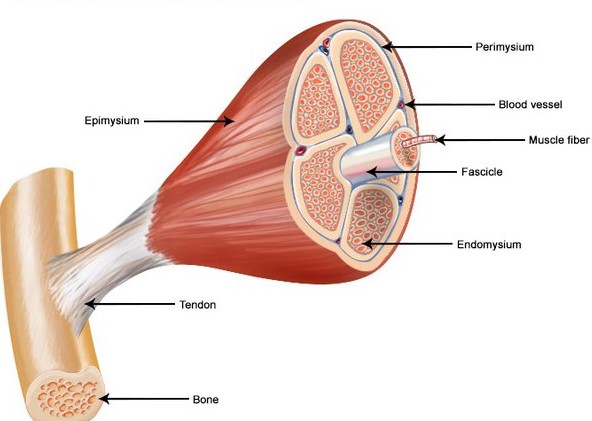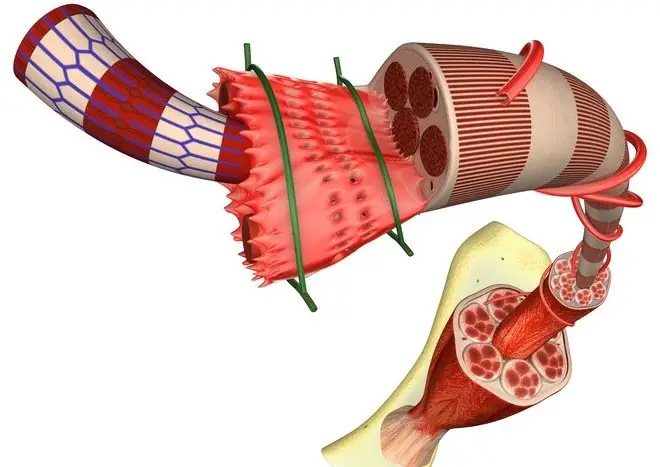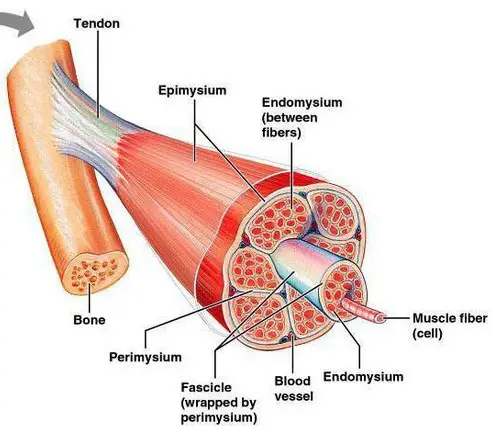Muscle anatomy, with its myriad components and complex structures, plays a crucial role in our daily movements, athletic performance, and overall health. Among these components, epimysium and fascia stand out due to their significant functions and contributions to muscle functionality. Both structures are integral to the muscle system, yet they serve distinctly different purposes.
The epimysium is a fibrous tissue layer that envelops the entire muscle, providing structural integrity and facilitating the transmission of muscular force. On the other hand, fascia is a broader connective tissue that not only surrounds muscles but also connects them to other parts of the body, playing a key role in overall movement and stability. The difference between these two lies in their location, structure, and function within the muscle anatomy.
Understanding the roles and differences of epimysium and fascia is essential for anyone interested in muscle health, from athletes looking to optimize performance to individuals recovering from injuries. These components’ interplay is vital for maintaining muscle integrity, flexibility, and strength, influencing how we move, respond to physical stress, and heal from muscular damage.

Muscle Anatomy 101
Muscle Components
Muscles are fundamental to our ability to move, maintain posture, and perform daily activities. Understanding muscle structure provides insight into how these complex systems operate.
Overview of Muscle Structure
At its core, a muscle is made up of fibers bundled together, each encased in connective tissue. These fibers contract to produce movement. Muscles attach to bones via tendons, translating the contraction into action. Within each muscle, smaller units known as muscle fibers work together, showcasing the intricate design of the human body.
Role of Connective Tissue in Muscles
Connective tissue in muscles plays a crucial role in providing support, structure, and protection. It forms a network that helps distribute forces applied to muscles, reducing the risk of injury. Additionally, it ensures nutrient delivery and waste removal, essential for muscle health and recovery.
What is Epimysium?
Definition and Characteristics
Epimysium is a dense layer of connective tissue that envelops the entire muscle. It’s resilient, providing an essential barrier against friction and damage. This layer distinguishes itself by its toughness and elasticity, allowing muscles to stretch and contract without harm.
Function of Epimysium in Muscle Health
The primary function of epimysium is to maintain muscle integrity and facilitate the transmission of muscular force. By enveloping the whole muscle, it ensures that the generated force is evenly distributed, leading to efficient movement. It also protects the muscle from external impacts and injuries.
What is Fascia?
Definition and Characteristics
Fascia is a connective tissue that extends beyond muscles, providing a continuous sheath throughout the body. It supports not only muscles but also organs and nerves, contributing to body structure and movement. Fascia is flexible yet durable, capable of withstanding tension while maintaining the integrity of bodily structures.
Types of Fascia and Their Functions
Fascia can be classified into several types, each serving distinct functions:
- Superficial fascia lies just beneath the skin, aiding in thermal regulation and cushioning.
- Deep fascia encases muscles, separating muscle groups and facilitating force transmission between them.
- Visceral fascia envelops organs, providing support and protection within the body cavities.
Each type plays a role in movement coordination, force distribution, and overall structural integrity.
Key Differences
Location and Coverage
Epimysium: Enveloping Individual Muscles
Epimysium specifically targets individual muscles, creating a dedicated sheath for each. This localized coverage ensures each muscle can operate independently, with its force and movement finely tuned.
Fascia: Broader Coverage Beyond Muscles
Fascia, in contrast, offers a broad, interconnected network that links muscles with other body parts. Its coverage extends beyond muscles, integrating various structures into a cohesive unit for optimized movement and support.
Structure and Composition
Comparison of Structural Features
While both epimysium and fascia are made of connective tissue, their structure and composition differ significantly. Epimysium is denser, designed to tightly wrap muscles. Fascia, however, has a more varied structure, adapting to its diverse roles throughout the body.
How Composition Affects Function
The specific composition of each determines their function. Epimysium’s dense makeup is perfect for protecting muscles and aiding in force transmission. Fascia’s elastic and resilient nature supports a wide range of movements and distributes force across the musculoskeletal system.
Functional Roles
Epimysium: Muscle Integrity and Force Transmission
Epimysium ensures that a muscle maintains its shape and structure, crucial for its ability to generate force efficiently. It’s instrumental in the direct transmission of this force to tendons and bones, facilitating movement.
Fascia: Movement Coordination and Force Distribution
Fascia plays a broader role in coordinating complex movements and distributing force evenly across the body. It helps maintain postural stability and allows for smooth transitions between movements, reducing the risk of strain or injury.

Interconnection and Interaction
The human body functions as a well-coordinated system, with each part playing a role in maintaining health and performance. Two critical components in this system, epimysium and fascia, though different, work in tandem to ensure efficient muscle function and structural integrity.
How Epimysium and Fascia Work Together
The relationship between epimysium and fascia is a prime example of the body’s interconnected nature. Epimysium, by enveloping individual muscles, allows for precise force transmission and muscle isolation. Fascia extends this functionality by integrating these individual units into a cohesive whole, allowing for complex movements and force distribution across different body parts. Together, they allow muscles to work in harmony, providing the strength and flexibility needed for movement and stability.
- Epimysium focuses on protecting and ensuring the functionality of individual muscles.
- Fascia integrates these muscles into the body’s overall structure, enhancing movement coordination.
This synergy is crucial for activities ranging from everyday motions to high-intensity athletic performances, ensuring that the body operates as a unified system.
Importance in Muscle Performance and Injury Prevention
The interplay between epimysium and fascia has significant implications for muscle performance and injury prevention. A healthy relationship between the two ensures:
- Optimal force transmission: Efficient movement and reduced energy expenditure.
- Injury prevention: Proper force distribution reduces the risk of muscle tears and strains.
By maintaining the health and function of these connective tissues, individuals can achieve better athletic performance and lower their risk of injury.
Clinical Significance
Injury and Recovery
Injuries to the epimysium or fascia can significantly impact an individual’s mobility and quality of life. Understanding these injuries and their recovery processes is essential for effective treatment and rehabilitation.
Common Injuries Affecting Epimysium and Fascia
- Strains and tears: Overstretching or tearing of these tissues can occur during excessive force application.
- Fascial adhesions: Overuse or injury can lead to fascial adhesions, restricting movement and causing pain.
These injuries can lead to reduced mobility, chronic pain, and a prolonged recovery process if not properly addressed.
Role in Muscle Repair and Physical Therapy
Physical therapy plays a crucial role in the recovery from epimysium and fascia injuries. Treatment focuses on:
- Restoring mobility: Through stretching and flexibility exercises.
- Strengthening muscles: Preventing future injuries by ensuring the muscles and connective tissues can withstand physical stresses.
A comprehensive rehabilitation program can help restore function and reduce the risk of future injuries.
Impact on Flexibility and Strength
The health of epimysium and fascia is directly linked to an individual’s flexibility and strength. These tissues support the muscles during movement, and their integrity is crucial for maintaining peak performance.
Influence of Healthy Epimysium and Fascia on Athletic Performance
Athletes with healthy epimysium and fascia can achieve:
- Greater flexibility: Allowing for a full range of motion and reducing the risk of injuries.
- Increased strength: Efficient force transmission leads to better performance.
Maintaining the health of these connective tissues is vital for athletes looking to optimize their physical capabilities.
Tips for Maintaining Epimysium and Fascia Health
Maintaining the health of epimysium and fascia is crucial for overall well-being and performance. Here are some tips to keep these tissues healthy:
- Regular stretching: Improves flexibility and reduces the risk of fascial adhesions.
- Adequate hydration: Keeps the fascia and other connective tissues flexible.
- Balanced diet: Nutrients like protein and vitamin C are essential for tissue repair and health.
- Proper exercise technique: Reduces the risk of injury to muscles and their connective tissues.
- Rest and recovery: Allows tissues to heal and prevents overuse injuries.
Frequently Asked Questions
What is Epimysium?
The epimysium is a dense layer of connective tissue that surrounds the entire muscle. It helps maintain the muscle’s shape and integrity, allows the transmission of forces generated by muscle contraction to the tendons, and ultimately to bones, facilitating movement. This protective layer also ensures that muscles can glide smoothly against each other during activities.
How Does Fascia Differ From Other Connective Tissues?
Fascia is unique in its extensive distribution throughout the body, enveloping not only muscles but also organs and nerves, providing a continuous structural framework. Unlike other connective tissues that are localized, such as ligaments and tendons which connect bones and muscles, fascia has a more global role in body mechanics, movement coordination, and even influencing blood flow and lymphatic drainage.
Why are Epimysium and Fascia Important for Athletes?
For athletes, both epimysium and fascia are critical in optimizing performance and preventing injuries. The epimysium supports muscle structure, allowing efficient force application, while the fascia reduces friction and distributes force evenly across muscles. Together, they enhance movement efficiency, flexibility, and resilience, making them key to athletic training and recovery strategies.
Can Damage to Epimysium or Fascia Affect Movement?
Yes, damage to either the epimysium or fascia can significantly affect movement. Injuries or strains in these tissues can lead to pain, reduced mobility, and compromised muscle function. This underscores the importance of proper conditioning, injury prevention practices, and targeted rehabilitation efforts to maintain the health and functionality of these critical connective tissues.
Conclusion
The distinction between epimysium and fascia is more than just anatomical trivia; it is foundational to understanding how our bodies move, respond to physical stress, and recover from injuries. The epimysium’s role in encapsulating individual muscles for optimal force transmission contrasts with the fascia’s broader purpose in providing structural support and facilitating movement across the muscular system. Together, they underscore the complexity and interconnectivity of the human body.
Appreciating the differences and interactions between epimysium and fascia can lead to better health outcomes, whether for an athlete aiming to improve performance or an individual recovering from a muscle injury. This knowledge empowers us to take more informed approaches to exercise, rehabilitation, and daily activities, ensuring our muscles and connective tissues remain healthy and functional.

